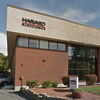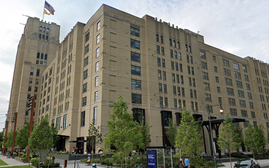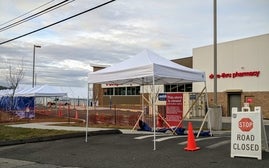Urgent care clinics gain momentum
 Dr. Sarika Aggarwal, chief medical officer for Fallon Health: “Everybody is looking for a version of true urgent care. It's good quality at a good cost.”
Dr. Sarika Aggarwal, chief medical officer for Fallon Health: “Everybody is looking for a version of true urgent care. It's good quality at a good cost.”
When given the option, healthy adults in their 20s or 30s often ditch the familiarity of an ongoing physician relationship for the convenience of walk-in service.
That's what Dr. Marc-David Munk came to realize after Reliant Medical Group opened walk-in ReadyMED Clinics in Shrewsbury and Auburn in 2009 and 2013.
Staffed by nurse practitioners, these clinics are open daily from 9 a.m. to 9 p.m., and have been very popular with younger adults for most of their medical needs, said Munk, Reliant's chief medical officer.
Often going by the wayside? A primary care doctor, which Munk said many young people don't see the value in having.
The overwhelming demand for ReadyMED services prompted Reliant to have its adult urgent care clinic in Worcester — which is staffed by physicians who can address more serious illnesses and injuries — adopt a walk-in model in April. It's also exploring whether to increase the level of services offered to more directly compete with hospitals' emergency departments.
As more people turn to same-day clinics, Munk said Reliant doctors have been able to leave fewer slots open for unanticipated emergencies and instead schedule regular patient appointments for those blocks several days in advance.
And Reliant is looking for expansion and partnership opportunities for its same-day offerings, Munk said.
Yet, a growing Reliant will encounter an increasingly crowded acute care landscape in Central Massachusetts.
CVS Caremark has cut the ribbon on 14 Central Massachusetts MinuteClinic locations since 2008 and plans to open three more by the end of the year. Meanwhile, AFC Doctors Express entered the region in 2012 with a Natick location, and plans to open two urgent care centers in the Worcester area by spring 2015.
And most of the region's major health care players — such as Reliant, Worcester-based UMass Memorial Health Care, Southbridge-based Harrington HealthCare System and Southboro Medical Group — have launched or expanded urgent care units in recent years, according to Dr. Sarika Aggarwal, chief medical officer for Fallon Health, of Worcester.
“Everybody is looking for a version of true urgent care,” Aggarwal said. “It's good quality at a good cost.”
Growing U.S. trend since 2008
This mirrors the trend nationwide, where roughly 300 urgent care centers have been opening annually since 2008 and roughly 9,000 such facilities are in operation today, more than half of them located in the suburbs, according to a study by Urgent Care Association of America (UCAOA), a professional association of medical personnel who work in urgent care facilities.
The migration to urgent care has been fueled largely by a lack of primary care doctors, according to Nancy Gagliano, MinuteClinic's chief medical officer.
The physician shortage is expected to grow from nearly 40,000 today to roughly 45,000 by 2020, the UCAOA found, as tens of millions of Americans gain health insurance through the Affordable Care Act and the baby boomers require more medical services as they age.
Some 66.6 million Americans lacked access to primary care as of June 2011, according to the U.S. Department of Health and Human Services, up from 56 million four years earlier.
“There's currently more demand for primary care than there is capacity,” said Gagliano, noting that half of MinuteClinic's patients don't have primary care providers.
Even for those who do, it's often tough to get in on short notice if a problem arises. More than 40 percent of Americans lack same- or next-day access to their physicians, the UCAOA found, while nearly two-thirds report difficulty seeing their doctor on nights, weekends or holidays.
Before urgent care centers came onto the Massachusetts scene, people without a doctor or who were suffering during odd hours tended to visit an emergency department.
But even for the same diagnosis, an emergency department visit will cost between $228 and $583 more than one at an urgent care clinic due to higher overhead and staffing costs, according to UCAOA data. More than a quarter of emergency-room visits are for conditions that are not life threatening and can be dealt with more easily by a primary care doctor or urgent care center.
Costs cut two ways
And with more Americans enrolled in high-deductible health plans, a massive emergency department co-pay would be a major burden for patients, said Rick Crews, Doctors Express New England president.
“People are tired of waiting in an emergency room for three to five hours to see a physician,” he said.
Walk-in clinics have also tried to differentiate themselves through improved customer service.
MinuteClinic, for instance, allows visitors to sign in using an electronic kiosk, Gagliano said, and will soon be able to alert patients via text message when their turn has arrived so they can do other chores in the interim (though the average wait time is just 22 minutes).
Meanwhile, Doctors Express makes chocolate chip cookies available in the waiting area and has flat-screen televisions installed in all exam rooms.
“People expect great medical care (from their primary doctor), but they don't expect a great experience,” Crews said.
Crews believes the Bay State can sustain another three years of robust expansion among urgent care facilities growth before it reaches its saturation point.
But Aggarwal said a development looms on the horizon that could one day displace urgent care centers: telemedicine.
Telehealth companies began sprouting up in California in the late 2000s, Aggarwal said, and online visits and televisits have been catching on in the Western and Central parts of the country since.
Though Massachusetts currently has restrictive telemedicine regulations, she sees a day when some of those rules are lifted, resulting in urgent care centers losing some of their clientele.
“For a cut, you'd go to urgent care,” Aggarwal said, “and for a cold, you'd use telecare.”












0 Comments